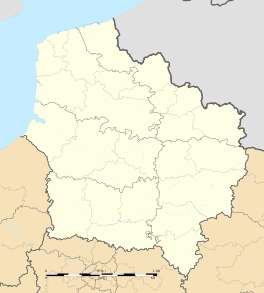Joncourt
| Joncourt | |
|---|---|
 Joncourt | |
|
Location within Hauts-de-France region  Joncourt | |
| Coordinates: 49°57′24″N 3°18′01″E / 49.9567°N 3.3003°E / 49.9567; 3.3003Coordinates: 49°57′24″N 3°18′01″E / 49.9567°N 3.3003°E / 49.9567; 3.3003 | |
| Country | France |
| Region | Hauts-de-France |
| Department | Aisne |
| Arrondissement | Saint-Quentin |
| Canton | Le Catelet |
| Government | |
| • Mayor (2008–2014) | René Brule |
| Area1 | 7.25 km2 (2.80 sq mi) |
| Population (2012)2 | 317 |
| • Density | 44/km2 (110/sq mi) |
| Time zone | CET (UTC+1) |
| • Summer (DST) | CEST (UTC+2) |
| INSEE/Postal code | 02392 / 02420 |
| Elevation |
108–153 m (354–502 ft) (avg. 145 m or 476 ft) |
|
1 French Land Register data, which excludes lakes, ponds, glaciers > 1 km² (0.386 sq mi or 247 acres) and river estuaries. 2 Population without double counting: residents of multiple communes (e.g., students and military personnel) only counted once. | |
Joncourt is a commune in the Aisne department in Hauts-de-France in northern France.
It lies near the St. Quentin Canal.
History
On 1 October 1918 during World War I, a battle was fought there that was described by the Allied media at that time as "the Miracle of the War", the 46th (North Midland) Division broke through the Hindenburg Line near the town at the canal. For his courage and leadership in the Joncourt action, the poet Wilfred Owen was posthumously awarded the Military Cross.
Population
| Historical population | ||
|---|---|---|
| Year | Pop. | ±% |
| 1962 | 313 | — |
| 1968 | 278 | −11.2% |
| 1975 | 250 | −10.1% |
| 1982 | 259 | +3.6% |
| 1990 | 302 | +16.6% |
| 1999 | 332 | +9.9% |
| 2008 | 326 | −1.8% |
| 2012 | 317 | −2.8% |
See also
References
| Wikimedia Commons has media related to Joncourt. |
This article is issued from Wikipedia - version of the 11/8/2016. The text is available under the Creative Commons Attribution/Share Alike but additional terms may apply for the media files.